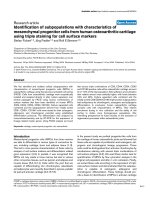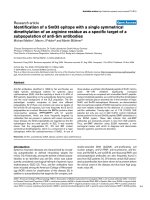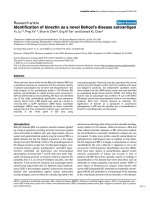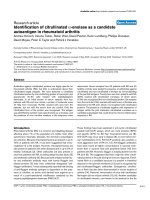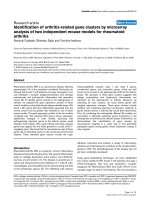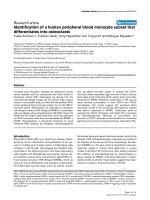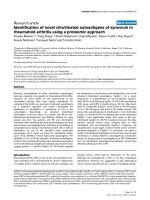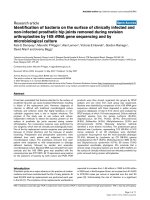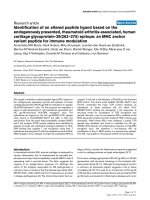Báo cáo y học: "Identification of Cellular Membrane Proteins Interacting with Hepatitis B Surface Antigen using Yeast Split-Ubiquitin System"
Bạn đang xem bản rút gọn của tài liệu. Xem và tải ngay bản đầy đủ của tài liệu tại đây (270.21 KB, 4 trang )
Int. J. Med. Sci. 2005 2
114
International Journal of Medical Sciences
ISSN 1449-1907 www.medsci.org 2005 2(3):114-117
©2005 Ivyspring International Publisher. All rights reserved
Short research communication
Identification of Cellular Membrane Proteins Interacting with Hepatitis B Surface
Antigen using Yeast Split-Ubiquitin System
Qi Chun Toh, Tuan Lin Tan, Wei Qiang Teo, Chin Yee Ho, Subhajeet Parida and Wei Ning Chen
Hepatitis Viruses and Liver Cancer Research Laboratory, School of Biological Sciences, Nanyang Technological University, 60
Nanyang Drive 05N-10, Singapore 637551
Corresponding address: Wei Ning Chen Tel: 65-63162870 Fax: 65-62259865 Email:
Received: 2005.05.13; Accepted: 2005.06.27; Published: 2005.07.05
Hepatitis B surface antigen (HBsAg) is the major component of the envelope of hepatitis B virus (HBV). As a resident
membrane protein in the endoplasmic reticulum, it plays a key role in the viral morphogenesis. Little is known about
cellular proteins that interact with HBsAg and thereby contributing to HBV morphogenesis. Using the yeast split-
ubiquitin system, a number of cellular membrane proteins have been isolated in this study. These include a resident
protein of endoplasmic reticulum (thioredoxin-related transmembrane protein 2), an adaptor protein involved in
clathrin-mediated endocytosis and HIV-mediated downregulation of CD4, and a co-receptor of coxsakie B virus. The
significance of our findings is suggested by the identification of cellular membrane proteins interacting with other virus
proteins. Further functional analysis of these HBsAg- interacting cellular membrane proteins should shed new insights
on their role in HBV morphogenesis.
Keywords: HBsAg, Morphogenesis, Cellular Membrane Proteins, Split-ubiquitin Screening System
1. Introduction
Hepatitis B virus (HBV) is a small DNA virus
consisting of a nucleocapsid which protects the 3.2 kb
viral genome [1]. The nucleocapsid is surrounded by an
envelope in which the major protein component is the 226
amino acid hepatitis B surface antigen (HBsAg). In
addition to its involvement as an envelope protein of the
infectious HBV particles, HBsAg is capable of forming
into lipoprotein subviral particles (without the
nucleocapsid and HBV genome) that are secreted from
infected cells. Inappropriate secretion of HBsAg subviral
particles with notably its intracellular storage has been
clinically implicated in the pathogenesis of chronic
hepatitis B [2].
One important step in HBV replication cycle is the
viral morphogenesis, particularly the interaction between
the nucleocapsid and HBsAg anchored at the endoplasmic
reticulum, leading to envelopment and secretion of
mature HBV particles [3]. Despite the recently reported
investigation on the role of chaperones [4], little is known
about general network of host cellular proteins that is
needed for HBV morphogenesis. While conventional yeast
two hybrid screening has been successful in isolating
soluble cellular proteins interacting with a bait of interest
[5], it can not be applied in the isolation of those
interacting with transmembrane bait proteins such as
HBsAg.
A yeast split-ubiquitin screening system for the
characterization of membrane protein-protein interactions
has been described [6-8]. We report in this study the
application of this system to identify cellular membrane
proteins interacting with HBsAg. The significance of our
finding in the perspective of better understanding HBV
morphogenesis is discussed.
2. Materials and methods
Plasmids and reagents were contained in
DUALmembrane Kit (DUALSystems Biotech,
Switzerland).
2.1 Amplification and Cloning of HBsAg
The 678bp HBsAg gene was amplified by PCR using
full length HBV DNA (adw2 serotype) as the template. The
oligonucleotide primers were designed as follows:
5’-TTAGGCCTAAAAATGGAGAACATCACATCAGGA-3’
5’-AAAACAGAGACCCATATGTAAATTGGTACCAATT-3’
The amplified PCR product was cloned into the
binding domain vector pTMBV4 in-frame with Cub (the
yeast ubiquitin). The construct was then used to transform
yeast S. cerevisiae DSY-1 strain by LiOAc method.
2.2 Construction of cDNA Library from HBV-transfected
HepG2 Cells
2.2.1 Cell Culture and Transfection
Human hepatomacellular carcinoma cell line,
HepG2, was grown in 12ml Dulbecco’s Modified Eagle’s
Medium (DMEM) (Gibco) supplemented with 20% fetal
calf serum and maintained in a saturated, humidified
environment of 5% CO
2
and 95% air at 37
o
C. The cell
density when confluent was approximately 2 x 10
6
HepG2
cells per 100mm dish. The replicative HBV genome was
constructed by cloning a linear form of viral genome into
mammalian expression vector pcDNA3.1 [9]. The linear
genome, containing the viral promoter at its 5’ end and
the region for termination of transcription at its 3’ end,
was then transfected into these cells as described [9]. The
ability of this genome in behaving as a replicative virus
was assessed by the amount of HBsAg particles produced
in the cell culture medium two days after its transfection
into HepG2 cells, using ImX semi-quantitative
measurement (Abbott Laboratories, USA).
Total RNA was extracted from these HBV-
transfected HepG2 cells, and used as template for the
Int. J. Med. Sci. 2005 2
115
synthesis of cDNA. The first strand cDNA was generated
using random hexamer primer from BD Matchmaker™
Library Construction & Screening Kits User Manual (BD
Biosciences, Clontech, USA). The second strand cDNA
was synthesized using Long-Distance PCR (LD-PCR). The
PCR mixture containing double stranded cDNA was
purified using BD CHROMA SPIN
TM
TE-400 Column.
2.2.2 Construction of cDNA Library in S. cerevisiae DSY-2 Strain
The cDNA library was prepared by transforming the
yeast S. cerevisiae DSY-2 strain, in which the cDNA
mixture was combined with pDL2-XN vector through
homologous recombination. Yeast colony PCR was done
for 22 randomly picked colonies to assess the size of
cDNA insert. For each colony picked, half was streaked on
SD/-Trp plate and the other half inoculated into a 20µl
PCR mix.
Three ml of the freezing medium (SD/-Trp, 15%
glycerol) was added to each plate and the yeast colonies
were dislodged off the plates using a sterile loop. The
suspension from each plate was then pooled together into
a 1-litre sterile conical flask. The pooled suspension was
given a mix by swirling before aliquoting into Falcon
tubes proportionally for centrifugation at 700 x g for 5
minutes. The supernatant was discarded and the pellet
was resuspended in half the original volume using
Freezing medium. 1ml of cells were then aliquoted into
ten 1.5ml microcentrifuge tubes, 10ml of cells were
aliquoted into five 15ml tubes and the remaining cells
aliquoted into 50ml Falcon tubes. The samples were then
stored at -80
o
C.
2.3 Split-Ubiquitin Yeast Two Hybrid Screening
2.3.1 Mating of S. cerevisiae DSY-1 (Bait) and S. cerevisiae DSY-2
(Prey)
The 1ml aliquot (≥2x10
7
cells) frozen cDNA library
was added to 5ml bait cells in a sterile 3-litre conical flask.
The mixture was incubated at 30
o
C for 24 hours with
gentle swirling at 30rpm. After 20 hours of mating, a drop
of the mating culture was checked under a phase-contrast
microscope at 400X magnification to check for the
presence of 2 haploids. The culture was split into two
50ml Falcon tubes and centrifuged at 1000 x g for 10
minutes. The 3-litre flask used for mating was rinsed
twice with 50ml of 0.5X YPDA/Kanamycin (50µg/ml) per
rinsed. Each rinse (50ml) was used to resuspend one
pellet. After resuspension, the tubes were centrifuged at
1000 x g for 10 minutes and the supernatant discarded.
The pellet was resuspended in 5ml 0.5X
YPDA/Kanamycin (50µg/ml) and combined into a total
volume of 10ml.
To calculate the mating efficiency, 100µl of a 1: 10
000, 1: 1 000, 1: 100 and 1:10 dilutions of the mating
mixture was spread onto SD/-Leu, SD/-Trp and SD/-
Leu/-Trp agar plates. The remaining mating mixture was
distributed evenly onto 5mM TDO-3AT plates with
plating volume of 200µl. The plates were sealed and
placed in a 30
o
C incubator for approximately 7 days.
2.3.2 Selection for S. cerevisiae Diploids Expressing Interacting
Proteins
A total of fifteen colonies were selected for the first
round of screening. Half of the colony was streaked on
SD/-Trp agar plate and the other half inoculated into 20µl
of PCR mix. PCR products were sequenced to determine
the identity of the interacting proteins.
3. Results and Discussion
3.1 Principle of Split-Ubiquitin Screening System
Studies have shown that the use of yeast two hybrid
system, which is a genetic assay for in vivo detection of
interactions of proteins, enables identification of protein-
protein interactions between a soluble bait and its
interacting prey [5]. However, such a screening system is
not suitable for the analysis of interaction between
membrane bound proteins.
The split-ubiquitin yeast two hybrid system has been
recently developed for the characterization of membrane
protein interactions to overcome this limitation [6-8]. In
this system, the ubiquitin is split into N-terminal ubiquitin
(Nub) and C-terminal ubiquitin (Cub) but the Nub and
Cub have high affinity towards each other and is able to
reassemble back together spontaneously into ubiquitin
protein. When Nub and Cub moieties bind together
within a cell, this would activate the ubiquitin-specific
protease (UBP) and hence, the transcriptional factor (TF)
will be cleaved off. The cleaved TFs such as protein A-
LexA-VP16 (PLV) will activate the expression of reporter
genes (LacZ and HIS3) in the nucleus. The interaction
between various membrane proteins will then be reflected
by the activity of these reporter gene products, which can
be measured similarly to the conventional yeast two
hybrid system.
The bait protein, which is the HBsAg, is fused to a
vector (pTMBV4) containing the Cub-reporter protein
complex. The prey protein, which is the human malignant
liver HepG2 cell transfected with HBV adw2 serotype, is
fused to vector (pDL2-XN) which contains a mutated
NubG domain. The fusion plasmids are then cloned into
the yeast cell and expressed on the cell membrane. If the
prey protein interacts with the bait protein, this would
bind the NubG and Cub domains together to form the
ubiquitin complex.
This complex will then be recognized by UBPs and
the TF that is located at the C terminus of Cub will be
cleaved off and result in downstream reactions, which is
the activation of LacZ and HIS3 reporter genes [7].
3.2 Identification of Cellular Membrane Proteins
Interacting with HBsAg
A number of cellular proteins have been isolated
using the conventional yeast two hybrid screening [10,
11]. However, these reported HBV interacting proteins
have all been isolated from normal liver cells that had not
been exposed to HBV, which may reflect physical but
physiologically not meaningful interactions. There is
therefore a need to comprehensively isolate and
characterize, in an environment, cellular proteins
interacting not only with soluble HBV proteins, but also
with membrane bound HBsAg.
To this end, a linearised form of HBV genome has
been constructed in the mammalian expression vector
pcDNA3.1 [9]. The linear HBV genome contained the viral
promoter at its 5’ end and the region for termination of
transcription at its 3’ end [9]. The ability of this genome in
behaving as a replicative virus after its transfection in
HepG2 cells was then measured by the amount of HBsAg
particles secreted into cell culture medium two days after
its transfection. Using the ImX semi-quantitative
measurement, results in Table 1 suggested that HBsAg
produced in the culture medium (rate of 65.8) was
significantly higher than the negative control (normal
Int. J. Med. Sci. 2005 2
116
culture medium with a rate of 4.3), but lower than the
positive control (rate of 221.4). Our results suggested that
a cellular environment exposed to HBV could be
generated by transfecting a replicative HBV genome.
Table 1. Semi-Quantitative Measurement of HBsAg Following
HBV-Transfection
Reaction Rate / Reactivity
Replicative HBV Genome 65.8 / Reactive
Positive Control 221.4 / Reactive
Negative Control 4.3 / Non-Reactive
A cDNA library was therefore constructed from
HBV-transfected HepG2 cells, using homologous
recombination in yeast. PCR analysis on randomly
selected colonies revealed a wide range of inserts from 250
bp (lanes, 2, 6 and 8, Fig. 1) to 1,500 bp (lane 10 and 13,
Fig. 1). In addition, cDNA insert was detected in all
selected colonies except colony 14. The wide range of
cDNA inserts and absence of empty vector as shown in
Fig. 1 indicated that the cDNA library constructed in this
study was suitable for the screening of cellular proteins
interacting with HBsAg.
Figure 1. Determination of Size of Inserts in cDNA Library
Constructed from HBV-transfected HepG2 Cells. The
construction of this cDNA library from HBV-infected HepG2
cells was described in MATERIALS AND METHODS. Yeast
colonies were selected randomly for PCR amplification. Size of
individual inserts reflected by the size of the amplified PCR
product was analysed on an agarose gel. Lane 1 to 22, PCR
product from each of the 22 randomly selected colonies. Lane 1
kb DNA Ladder, DNA molecular weight marker.
With HBsAg as bait, fifteen colonies were obtained
from screening the above cDNA library using the yeast
split-ubiquitin system. Sequence analysis revealed three
interacting cellular membrane proteins as summarized in
Table 2.
Table 2. Summary of Cellular Membrane Proteins Interacting
with HBsAg
Clone Cellular Membrane
Protein
Function Reference
1 Thioredoxin-related
transmembrane protein 2
(trx2)
Stimulate cell growth
and prevent apoptosis
[12, 13]
3 Adaptor-related protein
complex 2 (AP-2)
Clathrin-mediated
endocytosis and protein
sorting
[14, 15]
4 Decay accelerating factor
for complement (DAF)
Regulation of
complement activation
and virus co-receptor
[16, 17]
While the role of the ER resident protein trx2 [13] in
HBV morphogenesis remains to be elucidated, AP-2 and
DAF have been implicated in virus infections [15, 17]. A
major component of clathrin-associated adaptor protein
complex that is involved in the clathrin-mediated
endocytosis [14], AP-2 has also been involved in the
downregulation of CD4 and MHC class I molecules by nef
(a regulatory protein of HIV) thereby resulting in an
increased HIV virulence [15]. On the other hand, the
decay-accelerating factor (DAF) with its well-established
role in the inhibition of activation of complement cascade
[16] has recently been shown to be a co-receptor for
coxackie B virus and involved in the transcytosis of the
virus [17]. Further functional analysis of these HBsAg-
interacting cellular membrane proteins should shed new
insights on their role in HBV morphogenesis.
Acknowledgments
We thank Dr. Peter Lee Peng Foo for constructing the
bait plasmid. This work was supported by grant
03/1/22/18/229 (WN Chen) from the Biomedical
Research Council, Agency for Science, Technology and
Research, Singapore. TL Tan is a recipient of a graduate
research scholarship from Nanyang Technological
University, Singapore. QC Toh and WQ Teo are from
Ngee Ann Polytechnic, Singapore. CY Ho and S Parida are
undergraduate students from School of Biological
Sciences, Nanyang Technological University, Singapore.
Conflict of interest
None declared.
References
1. Chen WN, Oon CJ. Human hepatitis B
virus mutants: significance of molecular
changes. FEBS Lett. 1999; 453: 237-242.
2. Foo NC, Ahn BY, Ma X, Hyun W, Yen TS.
Cellular vacuolization and apoptosis
induced by hepatitis B virus large surface
protein. Hepatology 2002; 36: 1400-1407.
3. Khan N, Guarnieri M, Ahn SH et al.
Modulation of hepatitis B virus secretion
by naturally occurring mutations in the S
gene. J Virol 2004; 78: 3262-3270.
4. Prange R, Werr M, Loffler-Mary H.
Chaperones involved in hepatitis B virus
morphogenesis. Biol Cem 1999; 380: 305-
314.
5. Fields S, Sternglanz R. The two-hybrid
system: an assay for protein-protein
interactions. Trends Genet 1994; 10: 286-292.
6. Stagljar I, Korostensky C, Johnsson N, te Hessen S. A genetic system
based on split-ubiquitin for the analysis of interactions between
membrane proteins in vivo. Proc Natl Acad Sci USA 1998; 95: 5187-
5192.
7. Stagljar I, Fields S. Analysis of membrane protein interactions using
yeast-based technologies. Trends Biochem Sci 2002; 27: 559-563.
8. Thaminy S, Auerbach D, Arnoldo A, Stagljar I. Identification of
novel ErbB3-interacting factors using the split-ubiquitin membrane
yeast two-hybrid system. Genome Res 2003; 13: 1744-1753.
9. Chen WN, Oon CJ, Toh I. Altered antigenicities of hepatitis B virus
surface antigen carrying mutations outside the common ‘a’
determinant. Am J Gastroenterol 2000; 95: 1098-1099.
10. Huang CJ, Chen YJ, Ting LP. Hepatitis B virus core protein interacts
with the C-terminal region of actin-binding protein. J Biomed Sci
2000; 7: 160-168.
11. Zhang Z, Torii N, Furusaka A, Malayaman N, Hu Z, Liang TJ.
Structural and functional characterization of interaction between
hepatitis B virus X protein and the proteasome complex. J Biol
Chem 2000; 275: 15157-15165.
2000 bp
1500 bp
1000 bp
750 bp
500 bp
250 bp
1 2 3 4 5 6 7 8 9 10 11 12 13 14 15 16 17 18 19 20 21 22 1Kb
DNA
Ladder
Int. J. Med. Sci. 2005 2
117
12. Powis G, Mustacich D, Coon A. The role of the redox protein
thioredoxin in cell growth and cancer. Free Rad Biol Med 2000; 29:
312-322.
13. Meng X, Zhang C, Chen J et al. Cloning and identification of a novel
cDNA coding thioredoxin-related transmembrane protein 2.
Biochem Genet 2003; 41: 99-106.
14. Motley A, Bright NA, Seaman MN, Robinson MS. Clathrin-
mediated endocytosis in AP2-depleted cells. J Cell Biol 2003; 162:
909-918.
15. Piguet V, Trono D. The Nef protein of primate lentiviruses. Rev
Med Virol 1999; 9: 111-120.
16. Harris CL, Rushmere NK, Morgan BP. Molecular and functional
analysis of mouse decay accelerating factor (CD55). Biochem J 1999;
341: 821-829.
17. Selinka HC, Wolde A, Sauter M, Kandolf R, Klingel K. Virus-
receptor interactions of coxsackie B viruses and their putative
influence on cardiotropism. Med Microbiol Immunol 2004; 193: 127-
131.

